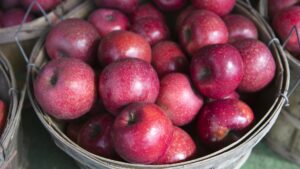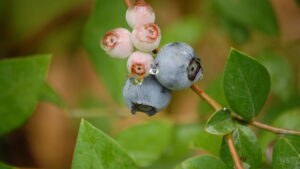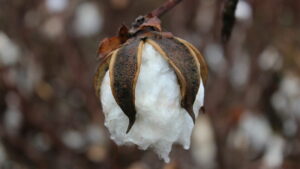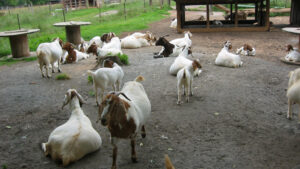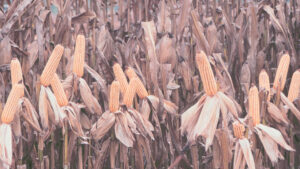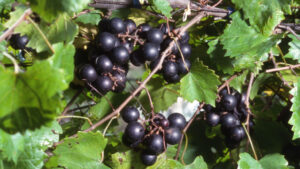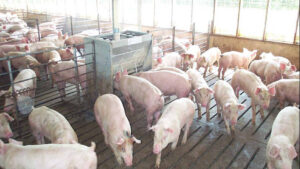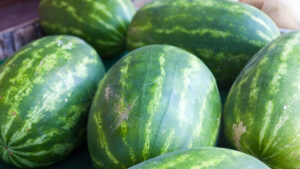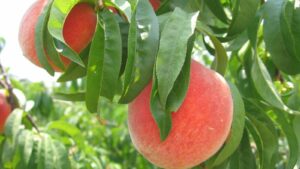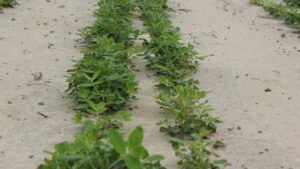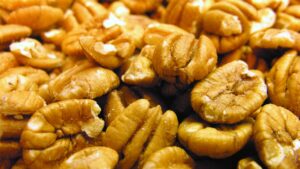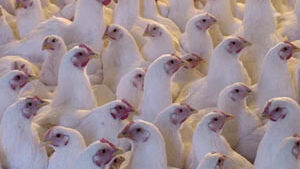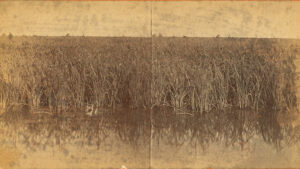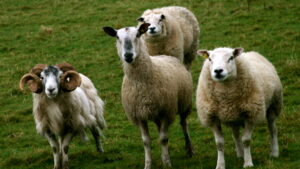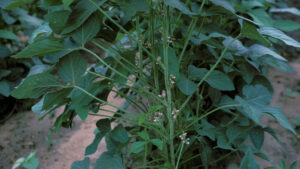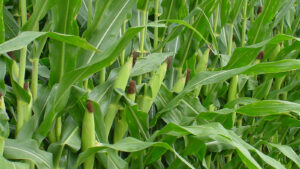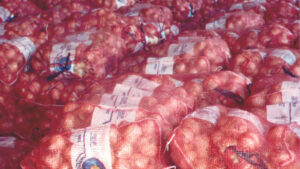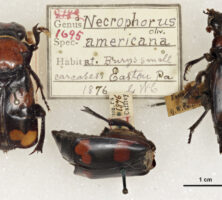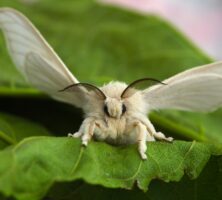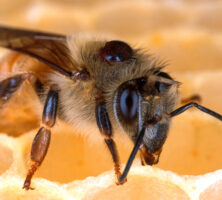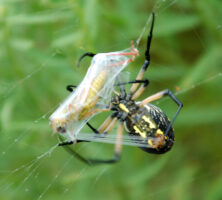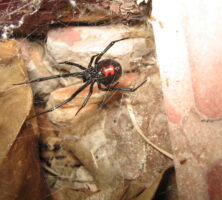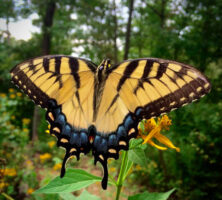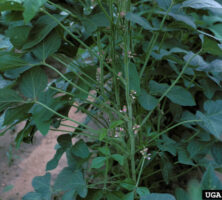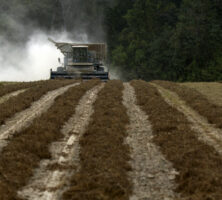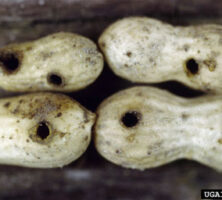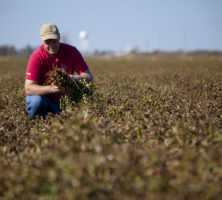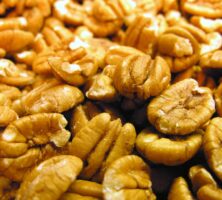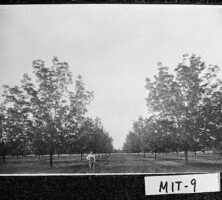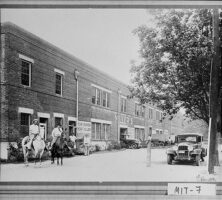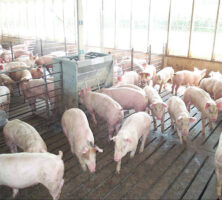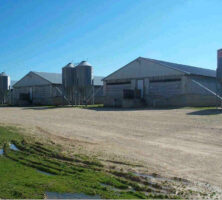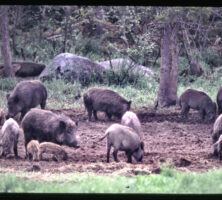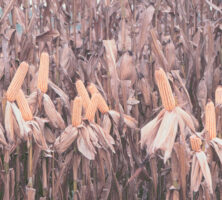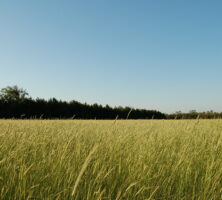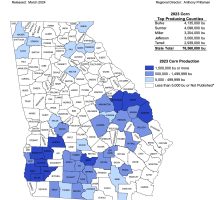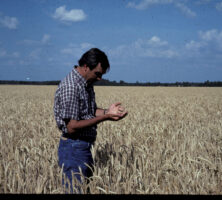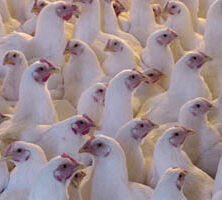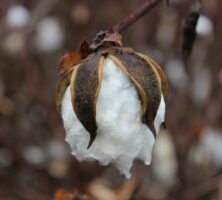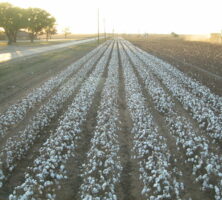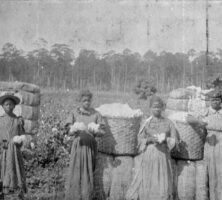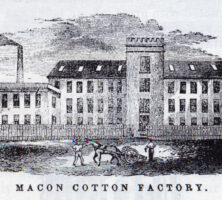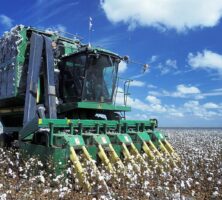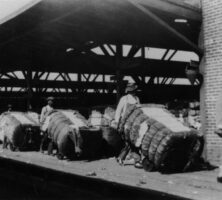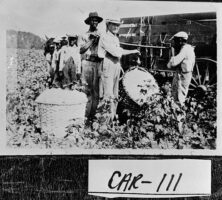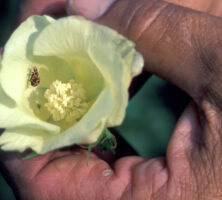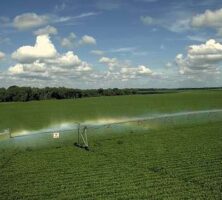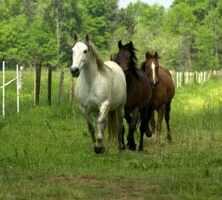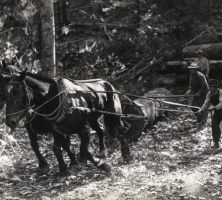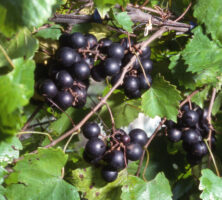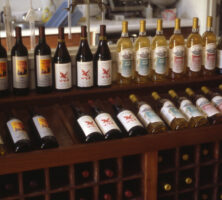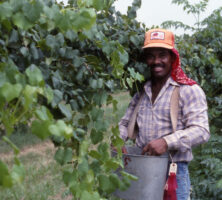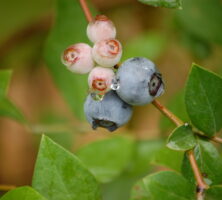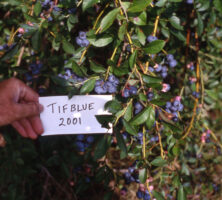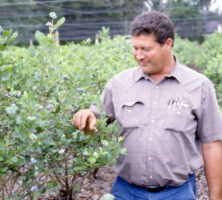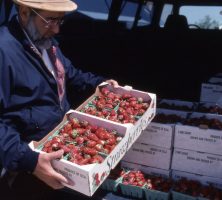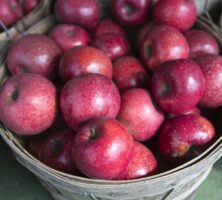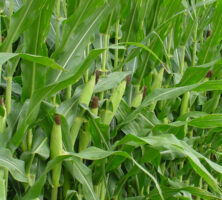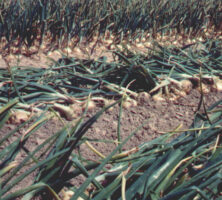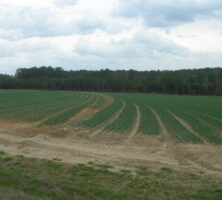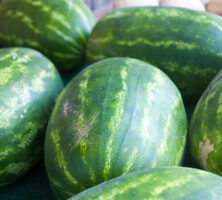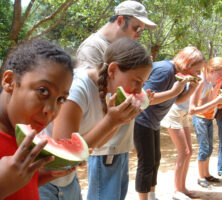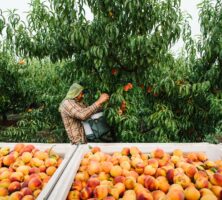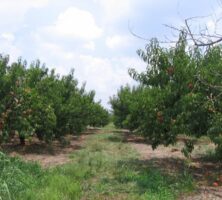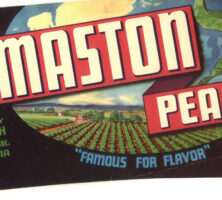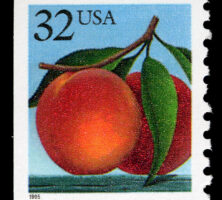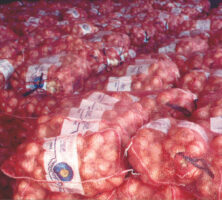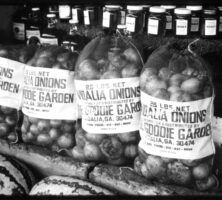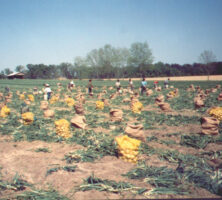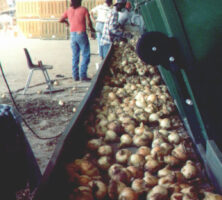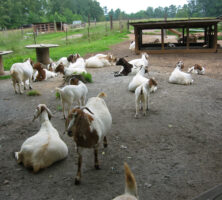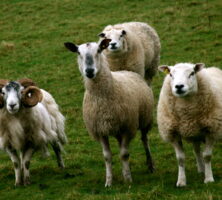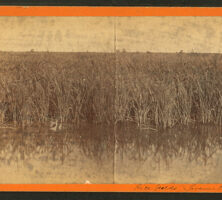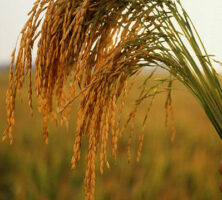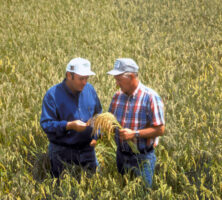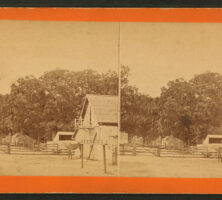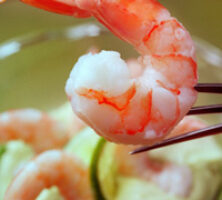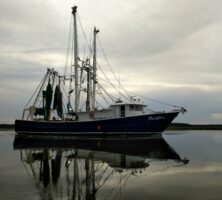The New Georgia Encyclopedia is supported by funding from A More Perfect Union, a special initiative of the National Endowment for the Humanities.
The American burying beetle, Nicrophorus americanus, is an endangered species and is no longer found in Georgia. Beetles, order Coleoptera, are the largest group of insects, and thousands of species can be found in Georgia.
Photograph by the Frost Museum
The New Georgia Encyclopedia does not hold the copyright for this media resource and can neither grant nor deny permission to republish or reproduce the image online or in print. All requests for permission to publish or reproduce the resource must be submitted to the rights holder.
European honeybees are not native to Georgia, but records show they arrived in the state by 1743. They were named the state insect in 1975. In addition to creating honey, honeybees pollinate several crops, including blueberries, apples, melons, and gourds.
Photograph by Waugsberg
The New Georgia Encyclopedia does not hold the copyright for this media resource and can neither grant nor deny permission to republish or reproduce the image online or in print. All requests for permission to publish or reproduce the resource must be submitted to the rights holder.
An adult silkmoth, Bombyx mori. This species's caterpillar, the mulberry silkworm, has produced silk textiles for millennia. Eighteenth-century Georgia colonists tried and failed to establish a silk industry in Savannah.
Photograph by Nikita
The New Georgia Encyclopedia does not hold the copyright for this media resource and can neither grant nor deny permission to republish or reproduce the image online or in print. All requests for permission to publish or reproduce the resource must be submitted to the rights holder.
Solenopsis invicta are an invasive ant species from South America. The species has interbred with native ants to create hybrid ant species that threaten soybean production. All ants are eusocial, which means they live in strict social hiearchies.
Courtesy of Atlanta Journal-Constitution.
The New Georgia Encyclopedia does not hold the copyright for this media resource and can neither grant nor deny permission to republish or reproduce the image online or in print. All requests for permission to publish or reproduce the resource must be submitted to the Atlanta Journal-Constitution.
Researchers have attributed recent declines in apiary honeybee populations to parasitic varroa mites, pictured between the bee's wings above. Varroa mites suck drone and developing brood blood, weakening individuals. An untreated varroa infestation may kill colonies.
Photograph by the U.S. Department of Agriculture
The New Georgia Encyclopedia does not hold the copyright for this media resource and can neither grant nor deny permission to republish or reproduce the image online or in print. All requests for permission to publish or reproduce the resource must be submitted to the rights holder.
The golden garden spider, Argiope aurantia, is a member of the orb-web family. Here, an individual uses its spinnerets, located on its abdomen, to trap prey. Spiders are exclusively carnivorous, though the golden garden spider is no danger to humans.
Photograph by Tom McC
The New Georgia Encyclopedia does not hold the copyright for this media resource and can neither grant nor deny permission to republish or reproduce the image online or in print. All requests for permission to publish or reproduce the resource must be submitted to the rights holder.
Widow spiders produce cobwebs and seclude themselves in dark, isolated areas. They have a painful bite, which requires medical attention, but they are rarely fatal.
Photograph by Charaj
The New Georgia Encyclopedia does not hold the copyright for this media resource and can neither grant nor deny permission to republish or reproduce the image online or in print. All requests for permission to publish or reproduce the resource must be submitted to the rights holder.
The eastern tiger swallowtail, Papilo glaucus, is the state butterfly of Georgia. It's common across the eastern United States.
Courtesy of Loy Xingwen
The New Georgia Encyclopedia does not hold the copyright for this media resource and can neither grant nor deny permission to republish or reproduce the image online or in print. All requests for permission to publish or reproduce the resource must be submitted to the rights holder.
The soybean plant, first introduced to Georgia in 1765, originated in China. The plant was brought to the Georgia colony by Samuel Bowen, who planted it after settling in Savannah. In the latter part of the nineteenth century, the U.S. Department of Agriculture encouraged the cultivation of soybeans in the state.
Photograph by Carl Dennis, Auburn University. Courtesy of IPM Images
The New Georgia Encyclopedia does not hold the copyright for this media resource and can neither grant nor deny permission to republish or reproduce the image online or in print. All requests for permission to publish or reproduce the resource must be submitted to the rights holder.
Mature soybeans, still in their pods, are ready for harvest. Most of the approximately 8.37 million bushels of soybeans produced annually in Georgia are used in the manufacture of cooking oil and animal feed.
Photograph by Scott Bauer, USDA Agricultural Research Service. Courtesy of IPM Images
The New Georgia Encyclopedia does not hold the copyright for this media resource and can neither grant nor deny permission to republish or reproduce the image online or in print. All requests for permission to publish or reproduce the resource must be submitted to the rights holder.
The New Georgia Encyclopedia does not hold the copyright for this media resource and can neither grant nor deny permission to republish or reproduce the image online or in print. All requests for permission to publish or reproduce the resource must be submitted to the rights holder.
The long growing season and sandy soils of Georgia are ideal for producing peanuts (Arachis hypogaea L.), a legume native to South America. Georgia produces nearly half of the country's peanuts.
Photograph by the Georgia Peanut Commission
The New Georgia Encyclopedia does not hold the copyright for this media resource and can neither grant nor deny permission to republish or reproduce the image online or in print. All requests for permission to publish or reproduce the resource must be submitted to the rights holder.
A peanut crop in Effingham County is harvested in 2005.
Photo by Stephen Morton, UGA College of Agriculture
The New Georgia Encyclopedia does not hold the copyright for this media resource and can neither grant nor deny permission to republish or reproduce the image online or in print. All requests for permission to publish or reproduce the resource must be submitted to the rights holder.
A load of peanuts is delivered to market in Seminole County by Irene Dozier (on ground), Millie Trulock (second from left on cab), and others in November 1941. The cultivation of peanuts, used to produce oil, was encouraged in Georgia during World War II.
Courtesy of Georgia Archives, Vanishing Georgia, #
sem104-82.
The New Georgia Encyclopedia does not hold the copyright for this media resource and can neither grant nor deny permission to republish or reproduce the image online or in print. Requests for permission to publish or reproduce the resource should be submitted to the Georgia Archives.
Peanut pods decay as a result of holes bored by wireworms, also known as click beetles, which feed on the underground portions of many Georgia crops.
Photograph by Steve L. Brown, University of Georgia. Courtesy of Forestry Images
The New Georgia Encyclopedia does not hold the copyright for this media resource and can neither grant nor deny permission to republish or reproduce the image online or in print. All requests for permission to publish or reproduce the resource must be submitted to the rights holder.
A peanut farmer investigates his crop. Representatives of all segments of the peanut industry, from grower to manufacturer, are active in Georgia, as are a variety of affiliated industries.
Photograph by uacescomm
The New Georgia Encyclopedia does not hold the copyright for this media resource and can neither grant nor deny permission to republish or reproduce the image online or in print. All requests for permission to publish or reproduce the resource must be submitted to the rights holder.
Peanuts, which are planted in April or May, are harvested in September.
Courtesy of Explore Georgia, Photograph by Ralph Daniel.
The New Georgia Encyclopedia does not hold the copyright for this media resource and can neither grant nor deny permission to republish or reproduce the image online or in print. Requests for permission to publish or reproduce the resource may need to be submitted to Explore Georgia.
During an oral history interview conducted in July 2014, Frank McGill recalls his career in the University of Georgia's Extension Service, becoming an expert on peanut production, and the effect of the peanut economy on small towns in Georgia.Interview with Frank McGill and Lois Boyd, First Person Project, FPP 53.
The New Georgia Encyclopedia does not hold the copyright for this media resource and can neither grant nor deny permission to republish or reproduce the image online or in print. Requests for permission to publish or reproduce the resource may need to be submitted to the Richard B. Russell Library for Political Research and Studies at the University of Georgia.
Pecan nuts are the fruit of pecan trees (Carya illinoensis), a species of hickory in the walnut family. First grown commercially in Georgia during the late 1880s, pecans became one of the state's most important commodities by the early 1900s. As of 2014 Georgia produced the most pecans in the country.
Photograph by Judy Baxter
The New Georgia Encyclopedia does not hold the copyright for this media resource and can neither grant nor deny permission to republish or reproduce the image online or in print. All requests for permission to publish or reproduce the resource must be submitted to the rights holder.
A farmer stands in a Mitchell County pecan grove in the early twentieth century. The grove was one of the first to be planted in the county. Pecans, along with cotton, peanuts, and soybeans, continue to be an important agricultural product in Mitchell County.
Courtesy of Georgia Archives, Vanishing Georgia, #
mit009.
The New Georgia Encyclopedia does not hold the copyright for this media resource and can neither grant nor deny permission to republish or reproduce the image online or in print. Requests for permission to publish or reproduce the resource should be submitted to the Georgia Archives.
Miller's Pecan Company, shown in 1932, was said to have been one of the largest pecan companies in the world during its time. Located in Baconton, in Mitchell County, the company cracked and shelled pecans, grading them by hand, and sold pecan tree saplings to growers.
Courtesy of Georgia Archives, Vanishing Georgia, #
mit007.
The New Georgia Encyclopedia does not hold the copyright for this media resource and can neither grant nor deny permission to republish or reproduce the image online or in print. Requests for permission to publish or reproduce the resource should be submitted to the Georgia Archives.
Since the 1950s Georgia has been the top producer of pecans in the nation.
Photograph by Mark Strozier
The New Georgia Encyclopedia does not hold the copyright for this media resource and can neither grant nor deny permission to republish or reproduce the image online or in print. All requests for permission to publish or reproduce the resource must be submitted to the rights holder.
Hog production in Georgia was responsible for 8 percent of the state's livestock and aquaculture income in 2004. The number of hogs raised in Georgia declined during the late twentieth century, dropping from a high of 2.4 million head in 1979 to 345,000 in 2002.
Courtesy of Ken Stalder, Department of Animal Science, Iowa State University
The New Georgia Encyclopedia does not hold the copyright for this media resource and can neither grant nor deny permission to republish or reproduce the image online or in print. All requests for permission to publish or reproduce the resource must be submitted to the rights holder.
Hogs tend to their young on a Colquitt County farm during the 1970s. First introduced to Georgia in the 1500s, hogs were raised by colonial settlers and became a primary food source during the nineteenth century. Hogs continued to be a major crop in the state until the 1980s.
Courtesy of Georgia Archives, Vanishing Georgia, #
clq099.
The New Georgia Encyclopedia does not hold the copyright for this media resource and can neither grant nor deny permission to republish or reproduce the image online or in print. Requests for permission to publish or reproduce the resource should be submitted to the Georgia Archives.
Although hogs were typically raised outdoors until the 1980s, today they are usually housed in environmentally controlled facilities. Such facilities allow farmers to increase the production of hogs while reducing the incidence of disease among the animals.
Courtesy of Ken Stalder, Department of Animal Science, Iowa State University
The New Georgia Encyclopedia does not hold the copyright for this media resource and can neither grant nor deny permission to republish or reproduce the image online or in print. All requests for permission to publish or reproduce the resource must be submitted to the rights holder.
Although feral, or wild, hogs are found througout the state, their population is concentrated in coastal areas. Considered a nuisance, feral hogs are destructive to both human crops and structures and are also known to carry diseases communicable to farm and domestic animals.
Courtesy of Wildlife Resources Division, Georgia Department of Natural Resources
The New Georgia Encyclopedia does not hold the copyright for this media resource and can neither grant nor deny permission to republish or reproduce the image online or in print. All requests for permission to publish or reproduce the resource must be submitted to the rights holder.
The New Georgia Encyclopedia does not hold the copyright for this media resource and can neither grant nor deny permission to republish or reproduce the image online or in print. All requests for permission to publish or reproduce the resource must be submitted to the rights holder.
The New Georgia Encyclopedia does not hold the copyright for this media resource and can neither grant nor deny permission to republish or reproduce the image online or in print. All requests for permission to publish or reproduce the resource must be submitted to the rights holder.
Several varieties of corn, including flour, flint, dent, pop, and sweet, are grown in Georgia during the summer months. Although the pop and sweet varieties are produced for human consumption, most of the corn raised in Georgia is used for animal feed.
Courtesy of Dewey Lee
The New Georgia Encyclopedia does not hold the copyright for this media resource and can neither grant nor deny permission to republish or reproduce the image online or in print. All requests for permission to publish or reproduce the resource must be submitted to the rights holder.
Most of the corn and wheat production in Georgia occurs in the southern counties. These areas are generally characterized by gently sloping or flat lands of well-drained soils, mostly of the clay loam to sandy loam soil types.
Image from Dizzy Girl
The New Georgia Encyclopedia does not hold the copyright for this media resource and can neither grant nor deny permission to republish or reproduce the image online or in print. All requests for permission to publish or reproduce the resource must be submitted to the rights holder.
Georgia's top corn-producing county in 2023 was Burke County, which produced more than 4.1 million bushels. Corn, the state's main summer crop, is grown primarily in south Georgia and often requires irrigation.
Courtesy of Georgia Agricultural Statistics Service
The New Georgia Encyclopedia does not hold the copyright for this media resource and can neither grant nor deny permission to republish or reproduce the image online or in print. All requests for permission to publish or reproduce the resource must be submitted to the rights holder.
A Georgia farmer examines his wheat crop, which is grown during the winter months. Soft red winter wheat, raised primarily for flour to be used in the baking industry, is the main variety produced in the state, although scientists are also experimenting with soft white wheat.
Courtesy of Dewey Lee
The New Georgia Encyclopedia does not hold the copyright for this media resource and can neither grant nor deny permission to republish or reproduce the image online or in print. All requests for permission to publish or reproduce the resource must be submitted to the rights holder.
In a north Georgia chicken house, thousands of hens lay hatching eggs for a company that exports the fertilized eggs to hatcheries around the world.
Courtesy of Carl Weinberg
The New Georgia Encyclopedia does not hold the copyright for this media resource and can neither grant nor deny permission to republish or reproduce the image online or in print. All requests for permission to publish or reproduce the resource must be submitted to the rights holder.
The J. D. Jewell, Incorporated, float in Gainesville's Poultry Festival Parade is pictured circa 1950. Georgia is one of the top producers of broilers in the nation.
Courtesy of Georgia Archives, Vanishing Georgia, #
hal388.
The New Georgia Encyclopedia does not hold the copyright for this media resource and can neither grant nor deny permission to republish or reproduce the image online or in print. Requests for permission to publish or reproduce the resource should be submitted to the Georgia Archives.
A Georgia poultry processing plant in 1961. The state's poultry industry produces an average of 24.6 million pounds of chicken and 14 million eggs daily.
Courtesy of Special Collections & Archives, Georgia State University Library, Tracy O'Neal Photographic Collection, 1923-1975.
The New Georgia Encyclopedia does not hold the copyright for this media resource and can neither grant nor deny permission to republish or reproduce the image online or in print. Requests for permission to publish or reproduce the resource should be submitted to Special Collections and Archives at Georgia State University.
Abit Massey served as president of the Georgia Poultry Federation for forty-eight years and was named president emeritus in 2009. In an oral history interview conducted on September 19, 2011, Massey discusses the birth of the poultry industry in Georgia and its modern economic impact.
Courtesy of Richard B. Russell Library for Political Research and Studies, University of Georgia Libraries, Reflections on Georgia Politics Oral History Collection, #ROGP 131.
The New Georgia Encyclopedia does not hold the copyright for this media resource and can neither grant nor deny permission to republish or reproduce the image online or in print. Requests for permission to publish or reproduce the resource may need to be submitted to the Richard B. Russell Library for Political Research and Studies at the University of Georgia.
Cotton is no longer "king" in Georgia, but the crop is still grown, mostly on the Coastal Plain. Bulloch, Dooly, Colquitt, Mitchell, and Worth counties in south central and southwest Georgia were the top cotton producers in 2017.
Photograph by Michael Bass-Deschenes
The New Georgia Encyclopedia does not hold the copyright for this media resource and can neither grant nor deny permission to republish or reproduce the image online or in print. All requests for permission to publish or reproduce the resource must be submitted to the rights holder.
In the twenty-first century, most of the cotton in Georgia is produced by agribusinesses that manage large tracts of cotton land. In 2000 Georgia ranked second in the country in acreage of cotton.
Photograph by Kimberly Varderman
The New Georgia Encyclopedia does not hold the copyright for this media resource and can neither grant nor deny permission to republish or reproduce the image online or in print. All requests for permission to publish or reproduce the resource must be submitted to the rights holder.
Farm workers, pictured circa 1897, pose with their cotton harvest in Fitzgerald, the seat of Ben Hill County. In the decades following the Civil War, cotton fields were worked predominantly by Black sharecroppers.
Courtesy of Georgia Archives, Vanishing Georgia, #
ben139.
The New Georgia Encyclopedia does not hold the copyright for this media resource and can neither grant nor deny permission to republish or reproduce the image online or in print. Requests for permission to publish or reproduce the resource should be submitted to the Georgia Archives.
The New Georgia Encyclopedia does not hold the copyright for this media resource and can neither grant nor deny permission to republish or reproduce the image online or in print. All requests for permission to publish or reproduce the resource must be submitted to the rights holder.
Antebellum towns including Macon, Milledgeville, Madison, and Greensboro experimented with steam-powered cotton factories, with varying degrees of success. The steam-powered factories in Madison and Greensboro went broke in the 1850s, while those in Milledgeville and Macon survived to serve the Confederacy.
The New Georgia Encyclopedia does not hold the copyright for this media resource and can neither grant nor deny permission to republish or reproduce the image online or in print. All requests for permission to publish or reproduce the resource must be submitted to the rights holder.
An illustration depicts enslaved laborers working in a southern cotton field. After the Civil War the most important issue to white landowners was that many of their best cotton fields lay in disrepair and their cotton field labor had been emancipated.
Courtesy of Hargrett Rare Book and Manuscript Library, University of Georgia Libraries, Robert E. Williams Photographic Collection.
The New Georgia Encyclopedia does not hold the copyright for this media resource and can neither grant nor deny permission to republish or reproduce the image online or in print. Requests for permission to publish or reproduce the resource should be submitted to the Hargrett Manuscript and Rare Book Library at the University of Georgia.
Wokers for the Thomaston Mills in Upson County inspect a roll of cotton fabric. During the 1950s, inexpensive tufted cotton carpets began to replace higher-quality wool carpets in the marketplace.
Courtesy of Thomaston-Upson Archives
The New Georgia Encyclopedia does not hold the copyright for this media resource and can neither grant nor deny permission to republish or reproduce the image online or in print. All requests for permission to publish or reproduce the resource must be submitted to the rights holder.
The primary damage to cotton occurs when female boll weevils deposit eggs in fruiting structures on developing cotton plants.
Photograph from the Agricultural Research Service
The New Georgia Encyclopedia does not hold the copyright for this media resource and can neither grant nor deny permission to republish or reproduce the image online or in print. All requests for permission to publish or reproduce the resource must be submitted to the rights holder.
Tractors, beginning in the 1930s, and mechanical cotton pickers decades later, initially disrupted cotton production and the lives of those who worked in the fields. Today cotton farmers rely on the machinery.
Photograph from the Agricultural Research Service
The New Georgia Encyclopedia does not hold the copyright for this media resource and can neither grant nor deny permission to republish or reproduce the image online or in print. All requests for permission to publish or reproduce the resource must be submitted to the rights holder.
Cotton bales are prepared for shipping.
The New Georgia Encyclopedia does not hold the copyright for this media resource and can neither grant nor deny permission to republish or reproduce the image online or in print. Requests for permission to publish or reproduce the resource should be submitted to the Hargrett Manuscript and Rare Book Library at the University of Georgia.
Carroll County resident J. G. Richards Sr. (center) weighs a basket of cotton that has just been picked. Roosevelt Robinson is standing just behind Richards, along with other cotton pickers.
Courtesy of Georgia Archives, Vanishing Georgia, #
car111.
The New Georgia Encyclopedia does not hold the copyright for this media resource and can neither grant nor deny permission to republish or reproduce the image online or in print. Requests for permission to publish or reproduce the resource should be submitted to the Georgia Archives.
The presence of beneficial insects such as the lady bird beetles on this cotton bloom are testimony to the benefit of reduced pesticide use as a result of the boll weevil eradication program.
Courtesy of Agricultural Research Service. Photograph by Rob Flynn
The New Georgia Encyclopedia does not hold the copyright for this media resource and can neither grant nor deny permission to republish or reproduce the image online or in print. All requests for permission to publish or reproduce the resource must be submitted to the rights holder.
A center-pivot irrigation system uniformly waters a cotton crop. Such systems supplement rainfall on more than 1 million acres of farmland in Georgia.
Courtesy of Georgia Department of Economic Development.
The New Georgia Encyclopedia does not hold the copyright for this media resource and can neither grant nor deny permission to republish or reproduce the image online or in print. Requests for permission to publish or reproduce the resource may need to be submitted to the Georgia Department of Economic Development.
The New Georgia Encyclopedia does not hold the copyright for this media resource and can neither grant nor deny permission to republish or reproduce the image online or in print. All requests for permission to publish or reproduce the resource must be submitted to the rights holder.
Horses boarded on a farm near Tallapoosa, in Haralson County.
Courtesy of Atlanta Journal-Constitution.
The New Georgia Encyclopedia does not hold the copyright for this media resource and can neither grant nor deny permission to republish or reproduce the image online or in print. All requests for permission to publish or reproduce the resource must be submitted to the Atlanta Journal-Constitution.
Team of farm-horses hauling logs in north Georgia, 1943. The method is called "snaking" the logs.
Courtesy of Special Collections & Archives, Georgia State University Library, Atlanta Journal-Constitution Photographic Archive.
The New Georgia Encyclopedia does not hold the copyright for this media resource and can neither grant nor deny permission to republish or reproduce the image online or in print. Requests for permission to publish or reproduce the resource should be submitted to Special Collections and Archives at Georgia State University.
The New Georgia Encyclopedia does not hold the copyright for this media resource and can neither grant nor deny permission to republish or reproduce the image online or in print. All requests for permission to publish or reproduce the resource must be submitted to the rights holder.
The Georgia International Horse Park in Conyers was built for the 1996 Olympics. The park features a world-class steeplechase course.
Image from carterse
The New Georgia Encyclopedia does not hold the copyright for this media resource and can neither grant nor deny permission to republish or reproduce the image online or in print. All requests for permission to publish or reproduce the resource must be submitted to the rights holder.
Georgia leads the nation in the production of muscadine table grapes.
Courtesy of Gerard Krewer
The New Georgia Encyclopedia does not hold the copyright for this media resource and can neither grant nor deny permission to republish or reproduce the image online or in print. All requests for permission to publish or reproduce the resource must be submitted to the rights holder.
Almost 200 acres of vineyards at Chateau Elan, a winery in Braselton, are planted with Vitis vinifera varieties and French-American hybrids. Chateau Elan produces an average of 40,000 cases of wine annually.
Courtesy of Gerard Krewer
The New Georgia Encyclopedia does not hold the copyright for this media resource and can neither grant nor deny permission to republish or reproduce the image online or in print. All requests for permission to publish or reproduce the resource must be submitted to the rights holder.
The Georgia wine industry, with many award-winning wines, has retail sales around $10 million annually.
Courtesy of Gerard Krewer
The New Georgia Encyclopedia does not hold the copyright for this media resource and can neither grant nor deny permission to republish or reproduce the image online or in print. All requests for permission to publish or reproduce the resource must be submitted to the rights holder.
Muscadine grapes, which are grown primarily in north Georgia, are harvested in late summer or early fall.
Courtesy of Gerard Krewer
The New Georgia Encyclopedia does not hold the copyright for this media resource and can neither grant nor deny permission to republish or reproduce the image online or in print. All requests for permission to publish or reproduce the resource must be submitted to the rights holder.
Georgia's blueberry industry is concentrated in the flatwoods of southeast Georgia, and the fruit is shipped all over the world.
Photography by Andie aka "Andrea"
The New Georgia Encyclopedia does not hold the copyright for this media resource and can neither grant nor deny permission to republish or reproduce the image online or in print. All requests for permission to publish or reproduce the resource must be submitted to the rights holder.
Tifblue is a rabbiteye blueberry grown on about 40 percent of the blueberry acreage in Georgia.
Courtesy of Gerard Krewer
The New Georgia Encyclopedia does not hold the copyright for this media resource and can neither grant nor deny permission to republish or reproduce the image online or in print. All requests for permission to publish or reproduce the resource must be submitted to the rights holder.
A Baxley fruit grower inspects a field of early ripening southern highbush blueberries.
Courtesy of Gerard Krewer
The New Georgia Encyclopedia does not hold the copyright for this media resource and can neither grant nor deny permission to republish or reproduce the image online or in print. All requests for permission to publish or reproduce the resource must be submitted to the rights holder.
A mechanical harvester used to pick blueberries for the processing market.
Courtesy of Gerard Krewer
The New Georgia Encyclopedia does not hold the copyright for this media resource and can neither grant nor deny permission to republish or reproduce the image online or in print. All requests for permission to publish or reproduce the resource must be submitted to the rights holder.
A strawberry grower from Montezuma, with a fresh harvest.
Courtesy of Gerard Krewer
The New Georgia Encyclopedia does not hold the copyright for this media resource and can neither grant nor deny permission to republish or reproduce the image online or in print. All requests for permission to publish or reproduce the resource must be submitted to the rights holder.
The most popular apple varieties grown in Georgia include Empire, Fuji, Granny Smith, Jonagold, Jonathan, Ozark Gold, Paulard, Red Delicious, Rome Beauty, and Yates. The Annual Apple Festival, hosted each October in Ellijay, features a crafts show and vendors selling a variety of apple products.
Courtesy of Explore Georgia, Photograph by Ralph Daniel.
The New Georgia Encyclopedia does not hold the copyright for this media resource and can neither grant nor deny permission to republish or reproduce the image online or in print. Requests for permission to publish or reproduce the resource may need to be submitted to Explore Georgia.
A small area of concentrated vegetable production exists in north Georgia. Most of this production is related to cabbage, pumpkins, tomatoes, and sweet corn.
Courtesy of Dewey Lee
The New Georgia Encyclopedia does not hold the copyright for this media resource and can neither grant nor deny permission to republish or reproduce the image online or in print. All requests for permission to publish or reproduce the resource must be submitted to the rights holder.
At harvest time, when the necks of the onions get weak and begin to fall over, growers undercut the onions to allow them to dry down. Vidalia onions mature from mid-April to mid-June.
Courtesy of Reid L. Torrance
The New Georgia Encyclopedia does not hold the copyright for this media resource and can neither grant nor deny permission to republish or reproduce the image online or in print. All requests for permission to publish or reproduce the resource must be submitted to the rights holder.
A small area of concentrated vegetable production, mostly cabbage, pumpkins, tomatoes, and sweet corn, exists north of Atlanta. A cabbage farm in Fannin County is pictured.
Courtesy of Georgia Department of Economic Development.
The New Georgia Encyclopedia does not hold the copyright for this media resource and can neither grant nor deny permission to republish or reproduce the image online or in print. Requests for permission to publish or reproduce the resource may need to be submitted to the Georgia Department of Economic Development.
Direct seeded onions are grown for the production of transplants, which are later pulled and replanted by hand.
Photograph by Jimmy Emerson, DVM
The New Georgia Encyclopedia does not hold the copyright for this media resource and can neither grant nor deny permission to republish or reproduce the image online or in print. All requests for permission to publish or reproduce the resource must be submitted to the rights holder.
Watermelons (Citrullus lanatus) are sold alongside other Georgia produce. In addition to being sold locally, Georgia's watermelons are also shipped to markets in the northern states and Canada.
Image from Kevin Trotman
The New Georgia Encyclopedia does not hold the copyright for this media resource and can neither grant nor deny permission to republish or reproduce the image online or in print. All requests for permission to publish or reproduce the resource must be submitted to the rights holder.
Watermelons are a favorite refreshment at the Independence Day celebration in Westville.
Courtesy of Matthew M. Moye
The New Georgia Encyclopedia does not hold the copyright for this media resource and can neither grant nor deny permission to republish or reproduce the image online or in print. All requests for permission to publish or reproduce the resource must be submitted to the rights holder.
The Elberta peach variety, which flourishes along the state's fall line, spurred Georgia peach production, and by the early 1900s Georgia was the leading peach grower in the nation.
Photo by AbbydonKrafts
The New Georgia Encyclopedia does not hold the copyright for this media resource and can neither grant nor deny permission to republish or reproduce the image online or in print. All requests for permission to publish or reproduce the resource must be submitted to the rights holder.
Harvesting peaches in Peach County, the self-proclaimed "Peach Capital of the World."
Courtesy of Explore Georgia, Photograph by Andrew Thomas Lee.
The New Georgia Encyclopedia does not hold the copyright for this media resource and can neither grant nor deny permission to republish or reproduce the image online or in print. Requests for permission to publish or reproduce the resource may need to be submitted to Explore Georgia.
Peaches all but vanished in Upson County with the onset of the Great Depression as laborers entered work in the mills rather than working in the orchards. Peach orchards were cut down in favor of the timber industry.
Courtesy of Thomaston-Upson Archives
The New Georgia Encyclopedia does not hold the copyright for this media resource and can neither grant nor deny permission to republish or reproduce the image online or in print. All requests for permission to publish or reproduce the resource must be submitted to the rights holder.
More than 80 percent of Georgia's commercial peach crop is grown in the central part of the state. The fruit is usually available from mid-May until August.
Photograph by Chris Fannin
The New Georgia Encyclopedia does not hold the copyright for this media resource and can neither grant nor deny permission to republish or reproduce the image online or in print. All requests for permission to publish or reproduce the resource must be submitted to the rights holder.
In the 1920s the peach industry thrived in Upson County. At the turn of the twenty-first century Georgia's peach industry is concentrated in Crawford, Peach, Taylor, and Macon counties.
Courtesy of Thomaston-Upson Archives
The New Georgia Encyclopedia does not hold the copyright for this media resource and can neither grant nor deny permission to republish or reproduce the image online or in print. All requests for permission to publish or reproduce the resource must be submitted to the rights holder.
The peach, depicted on this 1995 U.S. postage stamp, is Georgia's official state fruit.
Courtesy of Smithsonian National Postal Museum
The New Georgia Encyclopedia does not hold the copyright for this media resource and can neither grant nor deny permission to republish or reproduce the image online or in print. All requests for permission to publish or reproduce the resource must be submitted to the rights holder.
Bags of sweet Vidalia onions are ready to be shipped. Vidalia onions represent about 40 percent of the total national spring onion production and have an estimated value of about $90 million in annual gross sales.
Courtesy of Reid L. Torrance
The New Georgia Encyclopedia does not hold the copyright for this media resource and can neither grant nor deny permission to republish or reproduce the image online or in print. All requests for permission to publish or reproduce the resource must be submitted to the rights holder.
Prized for their sweetness, Vidalia onions get their name from the Toombs County town where farmer Mose Coleman first marketed them in the 1930s.
Image from UGA CAES/Extension
The New Georgia Encyclopedia does not hold the copyright for this media resource and can neither grant nor deny permission to republish or reproduce the image online or in print. All requests for permission to publish or reproduce the resource must be submitted to the rights holder.
Georgia-grown Vidalia onions for sale at a roadside stand.
Courtesy of Georgia Department of Economic Development.
The New Georgia Encyclopedia does not hold the copyright for this media resource and can neither grant nor deny permission to republish or reproduce the image online or in print. Requests for permission to publish or reproduce the resource may need to be submitted to the Georgia Department of Economic Development.
Most of the Vidalia onion acreage is still harvested by hand, but mechanical harvesting is on the rise because of the high costs and extensive regulations involving farm labor.
Courtesy of Reid L. Torrance
The New Georgia Encyclopedia does not hold the copyright for this media resource and can neither grant nor deny permission to republish or reproduce the image online or in print. All requests for permission to publish or reproduce the resource must be submitted to the rights holder.
Harvested onions are transported to packing facilities for further drying, grading, and packaging. Onions to be stored are poured into bin boxes and placed in coolers.
Courtesy of Reid L. Torrance
The New Georgia Encyclopedia does not hold the copyright for this media resource and can neither grant nor deny permission to republish or reproduce the image online or in print. All requests for permission to publish or reproduce the resource must be submitted to the rights holder.
Raising goats for meat is a rapidly growing agricultural enterprise in Georgia. Tens of thousands of goats are raised in Georgia for the production of meat and dairy products.
Courtesy of UGA College of Veterinary Medicine
The New Georgia Encyclopedia does not hold the copyright for this media resource and can neither grant nor deny permission to republish or reproduce the image online or in print. All requests for permission to publish or reproduce the resource must be submitted to the rights holder.
The production and marketing of lamb meat and wool have been declining both nationally and in Georgia in recent decades. From a national high of nearly 40 million sheep in the 1940s, there are now about 7.5 million in the United States and fewer than 10,000 in Georgia.
Photograph by Mickey Champion
The New Georgia Encyclopedia does not hold the copyright for this media resource and can neither grant nor deny permission to republish or reproduce the image online or in print. All requests for permission to publish or reproduce the resource must be submitted to the rights holder.
A stereoscopic image of a flooded rice field in Savannah, circa 1880.
Photograph from O. Pierre Havens, Wikimedia
The New Georgia Encyclopedia does not hold the copyright for this media resource and can neither grant nor deny permission to republish or reproduce the image online or in print. All requests for permission to publish or reproduce the resource must be submitted to the rights holder.
Rice has been cultivated on coastal Georgia's marshlands since the mid-eighteenth century.
Photograph from Keith Weller
The New Georgia Encyclopedia does not hold the copyright for this media resource and can neither grant nor deny permission to republish or reproduce the image online or in print. All requests for permission to publish or reproduce the resource must be submitted to the rights holder.
Despite its huge importance to Georgia's economy, the rice industry was subject to relatively rigid geographical/environmental constraints, and it never utilized more than a small proportion of the available land in the Lowcountry, much less in Georgia as a whole. Even at its peak no more than 45,000 acres of land were devoted directly to rice production in Georgia.
Photograph by U.S. Department of Agriculture
The New Georgia Encyclopedia does not hold the copyright for this media resource and can neither grant nor deny permission to republish or reproduce the image online or in print. All requests for permission to publish or reproduce the resource must be submitted to the rights holder.
A stereoscopic photograph of a Savannah rice plantation, circa 1885.
Photograph by D. J. Ryan, Wikimedia
The New Georgia Encyclopedia does not hold the copyright for this media resource and can neither grant nor deny permission to republish or reproduce the image online or in print. All requests for permission to publish or reproduce the resource must be submitted to the rights holder.
Shrimp, a delicacy for seafood lovers, are Georgia's most valuable seafood crop. Shrimpers harvest between 4.5 million and 9.5 million pounds of shrimp each year along the state's coast.
Courtesy of Atlanta Journal-Constitution.
The New Georgia Encyclopedia does not hold the copyright for this media resource and can neither grant nor deny permission to republish or reproduce the image online or in print. All requests for permission to publish or reproduce the resource must be submitted to the Atlanta Journal-Constitution.
Two species of shrimp make up most of the catch in Georgia: white shrimp (Litopenaeus setiferus) and brown shrimp (Farfantepenaeus aztecus [pictured]).
Image from Robert Aguilar, Smithsonian Environmental Research Center
The New Georgia Encyclopedia does not hold the copyright for this media resource and can neither grant nor deny permission to republish or reproduce the image online or in print. All requests for permission to publish or reproduce the resource must be submitted to the rights holder.
The New Georgia Encyclopedia does not hold the copyright for this media resource and can neither grant nor deny permission to republish or reproduce the image online or in print. All requests for permission to publish or reproduce the resource must be submitted to the rights holder.
Between 4.5 million and 9.5 million pounds of heads-on shrimp are harvested annually in Georgia by a fleet of more than 500 boats (or trawlers), which are based all along the Georgia coast.
Image from Kevin
The New Georgia Encyclopedia does not hold the copyright for this media resource and can neither grant nor deny permission to republish or reproduce the image online or in print. All requests for permission to publish or reproduce the resource must be submitted to the rights holder.
